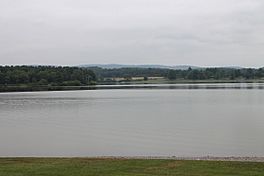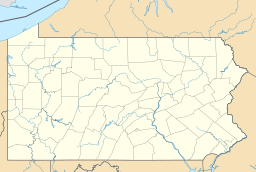Lake Chillisquaque facts for kids
Quick facts for kids Lake Chillisquaque |
|
|---|---|
| Montour Lake | |

Lake Chillisquaque from the west in July
|
|
| Location | Anthony Township, Montour County, Pennsylvania |
| Coordinates | 41°06′18″N 76°39′36″W / 41.105°N 76.660°W |
| Type | Reservoir |
| Etymology | Middle Branch Chillisquaque Creek |
| Primary inflows | primarily Middle Branch Chillisquaque Creek |
| Primary outflows | Middle Branch Chillisquaque Creek |
| Managing agency | PPL |
| Built | 1972 |
| Surface area | 165 acres (67 ha) |
| Max. depth | 40 feet (12 m) |
| Shore length1 | approximately 4.0 miles (6.4 km) |
| Surface elevation | 567 feet (173 m) |
| 1 Shore length is not a well-defined measure. | |
Lake Chillisquaque, also called Montour Lake, is a large lake and reservoir in Montour County, Pennsylvania. It covers an area of 165 acres. The lake gets its water from Middle Branch Chillisquaque Creek. It is even named after this creek!
Nearby towns include Danville and Washingtonville. The lake sits 567 feet (173 m) above sea level. It can be as deep as 40 feet (12 m). Lake Chillisquaque has several curvy areas called coves. These include Goose Cove, Heron Cove, and Jellyfish Cove.
A large dam holds the lake on its southern side. This dam is 2,000 feet (610 m) long and 54 feet (16 m) high. The lake's water contains natural elements like calcium and iron. It also has nitrogen and phosphorus. Sometimes, water from nearby farms flows into the lake.
The Pennsylvania energy company Talen owns Lake Chillisquaque. It was built in 1972. Its main job was to provide cooling water for the Montour Power Plant. The lake still helps cool the plant. But now, it's also a popular spot for fun activities.
About 200 different kinds of birds have been seen at the lake. More than 50 types of waterfowl fly past it during their yearly migration. Many kinds of fish live in the lake too. The Pennsylvania Fish and Boat Commission sometimes adds more fish to the lake. You can also find many trees, bushes, and plants around the lake. People enjoy fishing, boating, and hiking here. The lake is surrounded by the Montour Preserve, which is a nature preserve.
Contents
Exploring Lake Chillisquaque's Geography
Lake Chillisquaque is found in Anthony Township. It is located on Middle Branch Chillisquaque Creek. Other smaller streams also flow into the lake. It is about 11 miles (18 km) north of Danville. It is also 4 miles (6.4 km) north of Washingtonville.
You can reach the lake using Pennsylvania Route 44 and Pennsylvania Route 54. The closest road is Preserve Road/State Route 1006. The lake is 567 feet (173 m) above sea level. With its 165 acres, it is the biggest of 82 water bodies in Montour County. Lake Chillisquaque is the only reservoir in the county.
The lake is surrounded by forested hills and farmland. The Muncy Hills are located to the north of the lake.
Lake Depths and Coves
Many parts of Lake Chillisquaque are quite shallow. Most of Heron Cove is less than 10 feet (3.0 m) deep. A large area near the boat ramp is about 20 feet (6.1 m) deep. The deepest spots are near the dam, reaching 40 feet (12 m) deep.
The lake has several coves. These include Heron Cove, Jellyfish Cove, and Goose Cove. Goose Cove is in the northwestern part of the lake. There are also many other smaller coves and bays. To help fish, people have placed things like old tire reefs and cement blocks in the lake. There are also special platforms for turtles to sunbathe on.
The Lake Chillisquaque Dam
Lake Chillisquaque is held back by an earth-fill dam. It is called the Lake Chillisquaque Dam. This dam is on the southern side of the lake. It is 2,000 feet (610 m) long and 54 feet (16 m) high. The top of the dam is 12 feet (3.7 m) wide. It also serves as a road.
The inside of the dam is made of a silty clay material. The outside is made of weathered shale. Experts say that if the Lake Chillisquaque Dam were to break, it could cause damage. It might affect nearby towns like Strawberry Ridge and Washingtonville. It could also reduce power from the Montour Power Plant. This might cause a brownout in the area. A serious dam failure is seen as the biggest danger to Montour County.
Understanding Lake Chillisquaque's Water
The water temperature of Lake Chillisquaque changes with the seasons. In summer, it can range from 10.4 °C (50.7 °F) to 28.7 °C (83.7 °F). The lake's pH level, which tells how acidic or basic the water is, is usually between 6.6 and 9.3. The lake also experiences agricultural runoff. This happens because there are many farms near the lake.
The water contains different elements. These include calcium and magnesium. It also has tiny amounts of copper and lead. You can find iron, manganese, zinc, and aluminum in the water too.
Light also affects the lake. At the surface, the light is very bright. But 15 feet (4.6 m) below the surface, it is much dimmer. At this depth, mostly green light can be seen.
History and Name of Lake Chillisquaque
Lake Chillisquaque gets its name from Middle Branch Chillisquaque Creek. The word chillisquaque comes from a Native American word. It means "song of the wild goose."
The PPL company built the lake in 1972. The dam was finished in 1971. PPL still owns the lake today. The lake was first built to provide cooling water for the Montour Power Plant. It is still used for this purpose in emergencies. But over time, it also became a popular place for fun activities.
Animals of Lake Chillisquaque
About 200 different kinds of birds have been seen around Lake Chillisquaque. It is known as a great spot for migrating birds. Many birds, including over 50 types of waterfowl, fly past the lake in March. These include ducks, geese, swans, and other species. Shorebirds are also often seen here. The Montour Preserve and the lake are part of a special area for wild ringneck pheasants.
Fish Species in Lake Chillisquaque
The Pennsylvania Fish and Boat Commission adds many kinds of fish to Lake Chillisquaque. These include bullhead catfish, largemouth bass, yellow perch, and northern pike.
A survey in 2005 found that the most common fish was the black crappie. They found 717 of these fish. They were between 3 inches (7.6 cm) and 19 inches (48 cm) long. They also found 290 golden shiners. There were 168 bluegills, which were 2 inches (5.1 cm) to 9 inches (23 cm) long. The survey also found 106 walleyes, from 7 to 28 inches (18 to 71 cm) long.
Other fish found included yellow perch, pumpkinseeds, northern pikes, and white suckers. Less common fish were quillback carpsuckers, largemouth bass, rock bass, bluntnose minnows, common carp, fathead minnows, and green sunfish. Another survey found 54 walleyes and 48 largemouth bass.
Plants of Lake Chillisquaque
Twelve different tree species grow near Lake Chillisquaque. These include two kinds of oak and two kinds of maple. Other trees are red elm, boxelder, shagbark hickory, black tupelo, American basswood, eastern hop-hornbeam, black ash, and musclewood.
Ten kinds of shrubs also grow near the lake. These include three types of dogwood and two types of holly. You can also find multiflora rose, Morrow's honeysuckle, speckled alder, spicebush, and mayberry.
Eighteen kinds of herbs live around the lake. Five of these are sedges. You can see cattails and beds of grass along the lake's shores. A special plant called Rotala ramosior also grows well on the lake.
Tiny Life in Lake Chillisquaque: Microbes
Different kinds of tiny living things called cyanobacteria live in Lake Chillisquaque. These small organisms are also known as blue-green algae. The types of cyanobacteria found in the lake change throughout the year. They also vary depending on how deep you go in the water. Light plays a big role in which species live where.
For example, in September 2009, a type called Oscillatoria was very common on the surface. It made up about 75 percent of the tiny life there. Another type, Raphidiopsis, was also common. In May 2010, Navicula and Oscillatoria were the most common. A small amount of Anabaena was also present. By July 2010, Oscillatoria and Synechococcus were equally common. Anabaena was still there too.
Even 15 feet (4.6 m) below the surface, different microbes are found. In September 2009, Oscillatoria was still common there. But Xylophilus and Verrucomicrobia were also present. In May 2010, Dolichospermum was the most common deep in the lake. Synechococcus, Navicula, and Xylophilus were also found. By July 2010, Xylophilus made up almost 85 percent of the microbes deep in the lake.
Fun Activities at Lake Chillisquaque
Fishing is a popular activity on Lake Chillisquaque. This includes ice fishing in winter. Boating is also allowed at any time of day. However, boats that use gasoline are not allowed. Boating is also forbidden from March 15 to April 30 each year. You cannot boat in Goose Cove at any time.
The only place to launch a boat is on the eastern side of the lake. This is at the Heron Cove Boat Access Area. The Chilli Challenge triathlon uses the lake for its paddling part. The running part is on the Chillisuagi Trail.
Lake Chillisquaque is surrounded by the Montour Preserve. This nature preserve covers a thousand acres. It is also owned by PPL. A 148-acre wildlife refuge is also near the lake.
Hiking Trails Around the Lake
Two hiking trails go around the lake. They are called the Chillisuagi Trail and the Ridgefield Point Trail. Together, they are 4.8 miles (7.7 km) long. The Ridgefield Point Trail is not marked with special symbols.
The Chillisuagi Trail is wide and flat in some parts. But it gets hillier near Goose Cove. On the eastern side of the lake, the trail stays close to the water. On the western side, it goes through fields, meadows, and forests.
Jeff Mitchell, in his book Paddling Pennsylvania, says the scenery at Lake Chillisquaque is "good to very good." The lake is one of 18 lakes in Pennsylvania with special rules for catching panfish.




